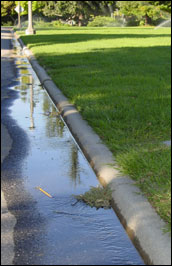| |
Cristina Milesi is too busy to think much about her small Northern California lawn, and it shows. She waters a little, when she can remember. Never fertilizes. She definitely doesn’t bag up her grass clippings. Where would she find the time for that? The mother of two young children, Milesi also works almost full time in the ecological forecasting research group at NASA’s Ames Research Center in California. “I have already let part of the yard go,” she says, which means some of it is a combination of bare patches and weeds.
Part of the reason Milesi has little time to be concerned with her own lawn is that she is busy thinking about everyone else’s. Since 2003, Milesi has been calculating how much of America’s land surface is lawn-covered and what impact all that grass has on our country’s water and carbon cycles.
“I think the interest in lawns started because I’m kind of an outsider,” she explains. Milesi moved to the United States from Italy in 1998. “When I first came here I lived in Montana, in a town that was surrounded by mountains. Past June, everything surrounding the town would turn brown and dry. A lot of the natural vegetation goes dormant in the summer. But then throughout our town, I would see these oases of green patches—people’s lawns. I had a neighbor who would water every day, even twice a day. It was not familiar to me." In Italy, she explains, people typically live at much higher population densities, with smaller yards that have little landscaping. "If there is grass in the yard, it is generally a mixture of clover, dandelions, and lots of other so-called weeds, able to survive the long dry summers with little additional water.”
Milesi was working on her Ph.D. at the University of Montana. To finish up her required hours of classes, she signed up for an e-business class. For the class’ final exam, students had to submit a proposal for an e-business. At the time, Milesi and her husband were expecting their first child. As many expectant mothers can testify, sometimes a slow, short stroll around the block is all the exercise they can manage. These strolls became the inspiration for Milesi’s business plan.
|
|

|
| |
“It was summer,” she recalls, “and all the sprinklers were running, with the water flowing down the driveways and collecting in little rivers down the street.” Sprinklers ran even on evenings when there had been a thunderstorm earlier in the day, obviously not an efficient use of water. “The e-business plan I came up with was an e-mail-based subscription service for homeowners that, based on current weather conditions and forecasts, would tell them if they needed to turn on their sprinklers and for how long.”
From the business point of view, Milesi wondered how many potential customers she might find in the United States, while the ecologist in her wondered how much water could be saved if her forecasting service prevented people from watering their lawns when it wasn’t really necessary. To answer either question, she needed to know how much surface area in the United States was covered by lawns.
But after hunting through published scientific research, Milesi was surprised to discover that no one had ever published an observation-based estimate of lawn surface area in the United States. Milesi couldn’t stop thinking about that missing piece of information—it seemed like an important part of the ecological picture of America. So after a few months, she submitted a research proposal to the NASA Earth System Science Fellowship Program to produce a national estimate of lawn area and the impact of those lawns on ecological factors like the carbon and water cycles. |
|

Sprinkler runoff creates a stream on the side of a street. Irrigated lawns have a significant impact on water supplies in American cities. (Photo courtesy Cristina Milesi.) |
| |
Most people don’t think about the impact of their lawns in the big ecological picture. We associate “fertilizer” or “irrigation” with food crops. We associate “carbon cycle” with fossil fuels and deforestation. But Milesi believes there are good reasons to think about the impact of lawns on the national water and carbon cycle.
For starters, she says, “This country has large variability in climate, and people are very mobile.” But although we move a lot, she says, we tend to recreate the same landscape wherever we go. “Most of the grasses used in U.S. lawns aren’t native to the area they are grown; many of the species come from the East, Kentucky bluegrass, for example. A lawn isn’t a big deal in the northeast, but when you recreate that same landscape out West, it becomes a major ecological issue because the only way to grow those grasses is with high use of water and nitrogen fertilizer. An individual, quarter-acre lawn isn’t a big ecological influence, but adding up all those quarter-acres for everyone in the country . . . We suspected that the ecological impact could be pretty big.”
 More Lawns than Irrigated Corn More Lawns than Irrigated Corn
|
|
Despite big differences in climate and soil conditions across the United States, most of the grasses used in U.S. lawns aren’t native to the area where they are being grown. In most parts of the country, lawns require large amounts of added fertilizer and water to survive. (Photo courtesy Cristina Milesi.) |

